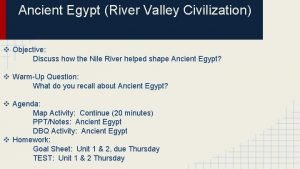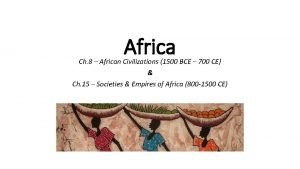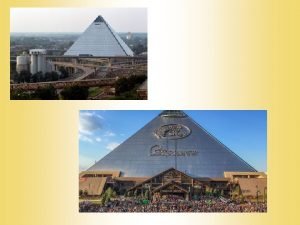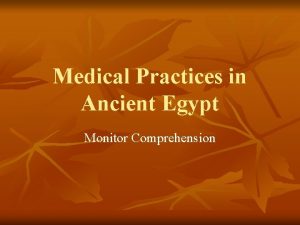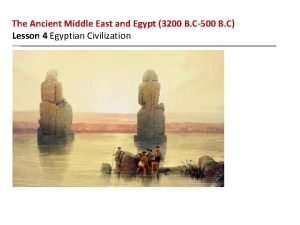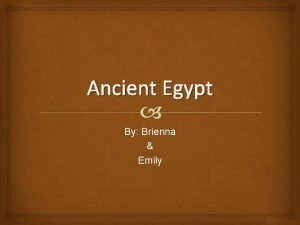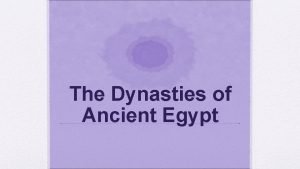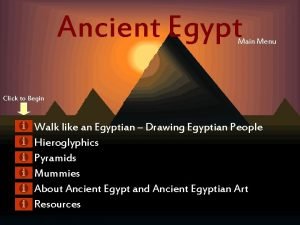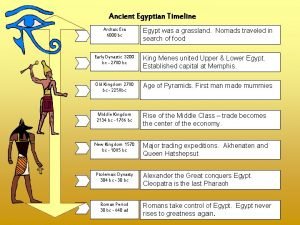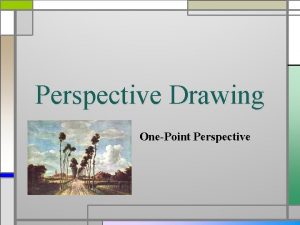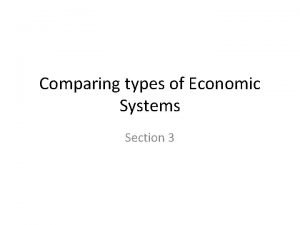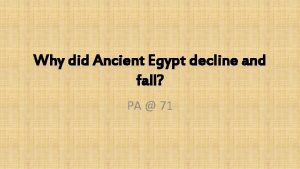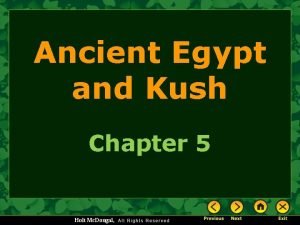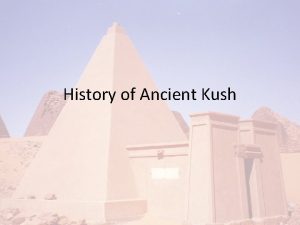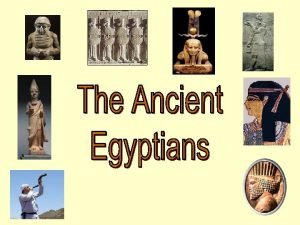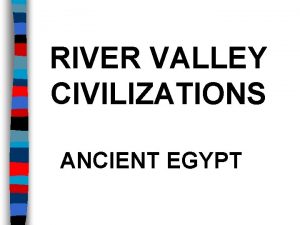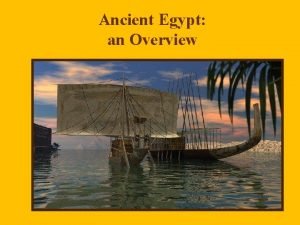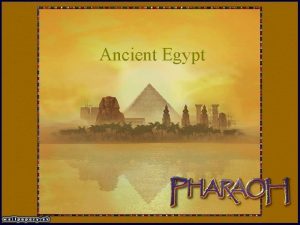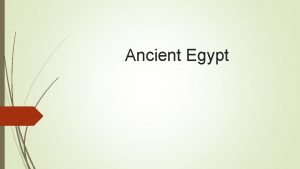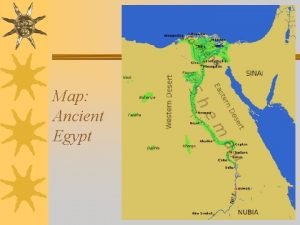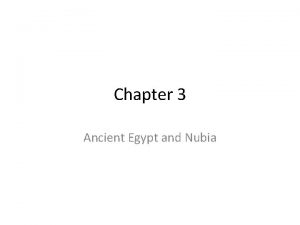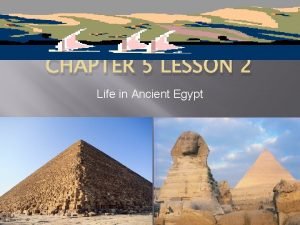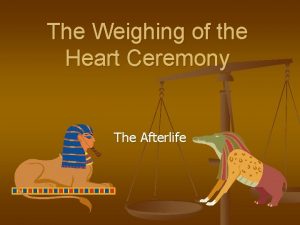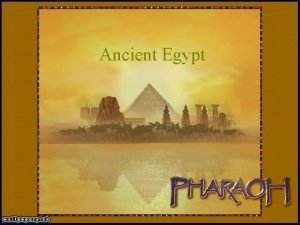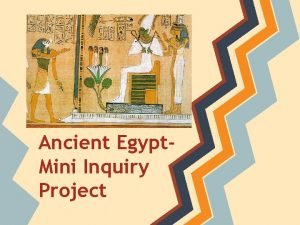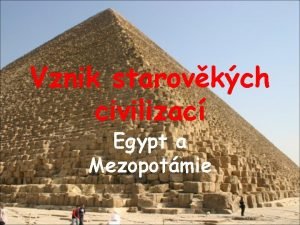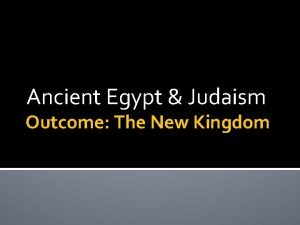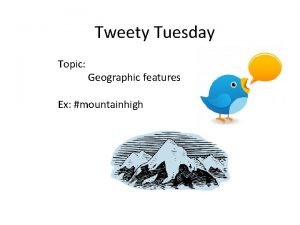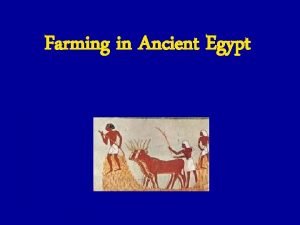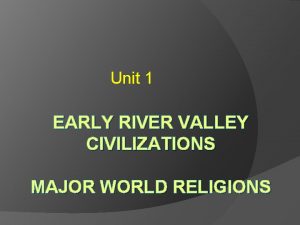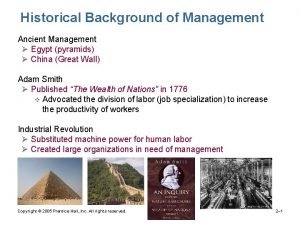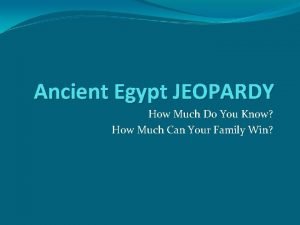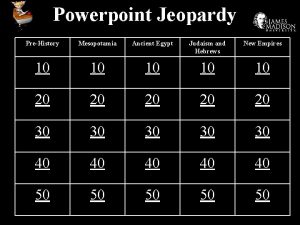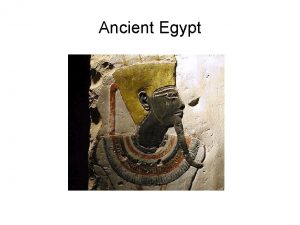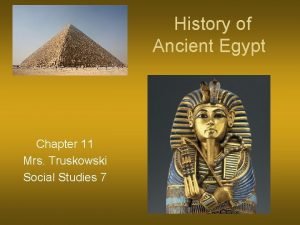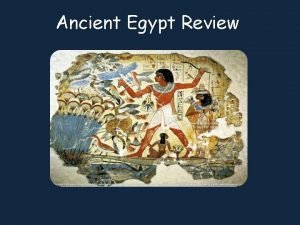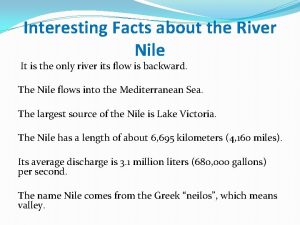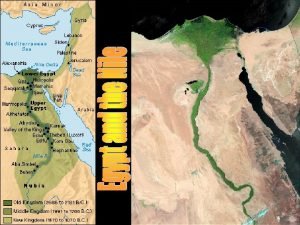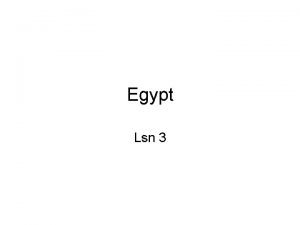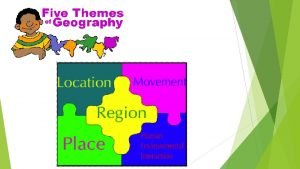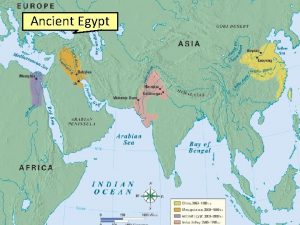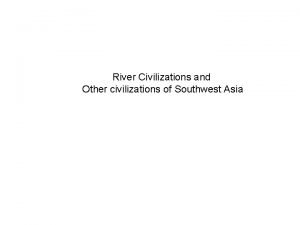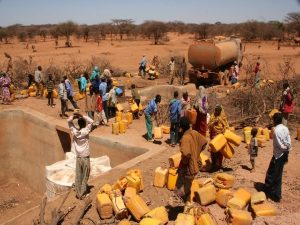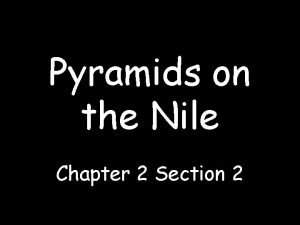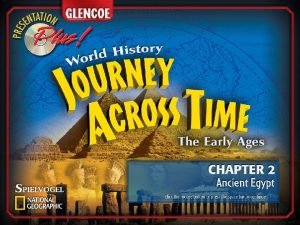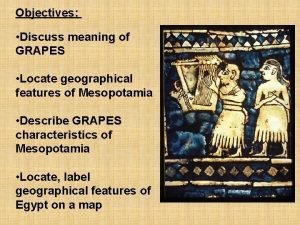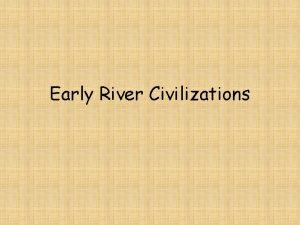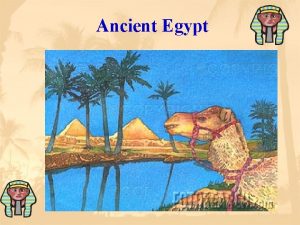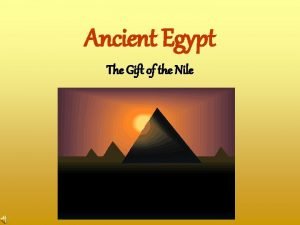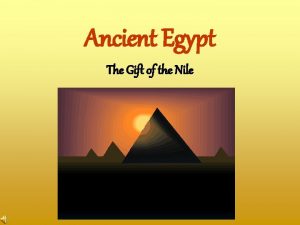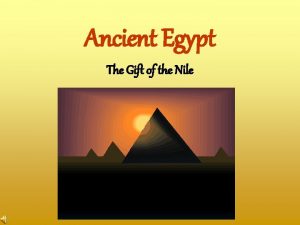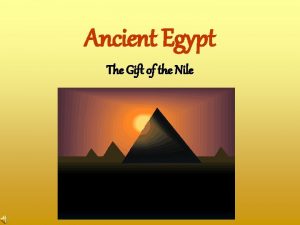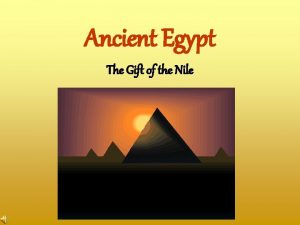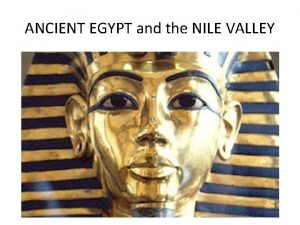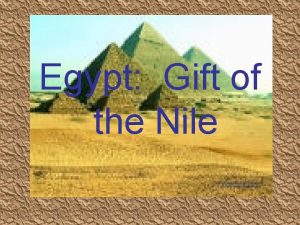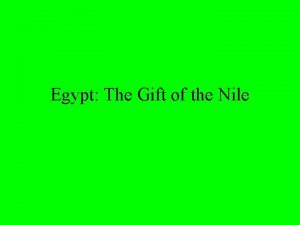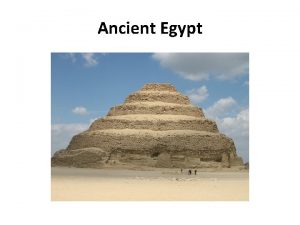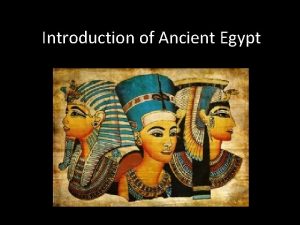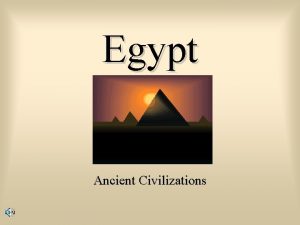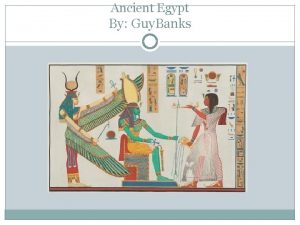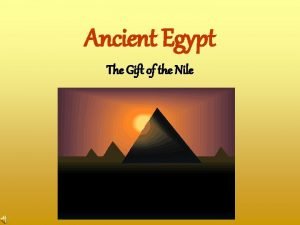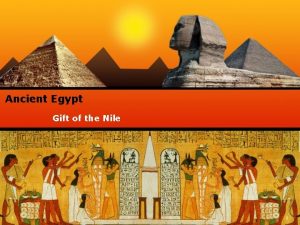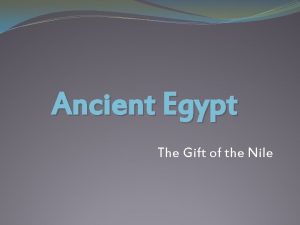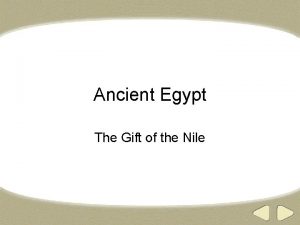Ancient Egypt The Gift of the Nile Historical





















































































- Slides: 85

Ancient Egypt The Gift of the Nile

Historical Overview Ancient Egypt was the birthplace of one of the World’s greatest civilizations. It was far more advanced than European tribes of the same time period, who were still in the Stone Age. Located in the northeast corner of Africa, Egypt grew to be an important civilization for over three hundred years because of the Nile River. Egypt was originally divided into two kingdoms: Upper Egypt and Lower Egypt.

Ancient Egyptian Time An Explanation First, the Egyptians developed a lunar calendar of 354 days. In time, the Egyptians created a more accurate 360 -day solar calendar BC - Means "Before Christ" - Religious BCE- Means “Before Common Era”- Scientific AD - Means "Anno Domini" (The Year of Our Lord)Religious CE- Means “Common Era”- Scientific Both of these terms were adopted during the early formation of the Roman/Christian calendar.

Ancient Egyptian Timeline Archaic Era 6000 bc Egypt was a grassland. Nomads traveled in search of food Early Dynastic 3200 bc - 2780 bc King Menes united Upper & Lower Egypt. Established capital at Memphis. Old Kingdom 2780 bc - 2258 bc Age of Pyramids. First man made mummies Middle Kingdom 2134 bc - 1786 bc Rise of the Middle Class – trade becomes the center of the economy. New Kingdom 1570 bc - 1085 bc Major trading expeditions. Akhenaten and Queen Hatshepsut Ptolemaic Dynasty 304 bc - 30 bc Roman Period 30 bc - 640 ad Alexander the Great conquers Egypt. Cleopatra is the last Pharaoh Romans take control of Egypt never rises to greatness again.

INTRODUCTION TO EGYPT • "Misr" - Ancient name of Egypt • Egypt was first settled about 5000 B. C. (7000 years ago) by nomads • Egyptian Civilization developed because of the Nile River

Egyptian Geography located in the northeast corner of Africa surrounded by natural barriers: • desert • mountains • Mediterranean Sea PROVIDED PROTECTION

The Nile River • Early people settled this area because of its location near a source of water. • The Nile River Valley had virtually no rainfall of its own. • Egypt was called "The Gift of the Nile" by Herodotus, a Greek historian. • flows north more than 4, 000 miles into the Mediterranean Sea world’s longest river • branches create a triangle shaped delta from deposited silt

The Important Uses of the Nile 1. Drinking & Bathing • The Nile provided the daily necessities of life in Ancient Egypt • Egyptians depended upon the annual flooding of the Nile

The Important Uses of the Nile 2. Agriculture • Inundation: June - October - SHAIT – time of rising flood waters – farmers had time to build • Emergence: November - February- PIRUIT – the return of the water to the river – planted crops & trapped water for irrigation • Drought: March - June - SHEMU – Harvest time

The Important Uses of the Nile • The Nile provided rich soil (from the silt) and water, producing three to four times more crops than regular rain-fed soil. - made farming very productive, created a surplus • The Egyptians invented the shadouf to help distribute water to the fields. • The Egyptians invented the plow. • The Egyptians domesticated animals to assist in farming.

The Important Uses of the Nile 3. Transportation • Egyptians built boats and traveled the Nile • The Nile linked all Egyptians - encouraged community life • Encouraged trade - used the surplus crops for barter

REVIEW 1. _____ Egypt was protected from invaders because: a. the Nile River flooded every year b. it was surrounded by natural barriers; desert, mountains, and the sea c. it was an island 2. _____ The Nile was important to the Egyptians for two main reasons: a. agriculture & transportation b. swimming & bathing c. fishing & water-skiing

REVIEW 3. _____ The flooding of the Nile River is known as: a. inundation b. emergence c. drought 4. _____ The Egyptians planted their crops during the time of the receding flood known as: a. inundation b. emergence c. drought 5. _____ The Egyptians harvested their crops during the time of: a. inundation b. emergence c. drought

REVIEW 6. _____ Egyptian farmers used irrigation to: a. water their crops b. make the soil more fertile c. control flood waters d. travel among the villages 7. _____ Transportation on the Nile was important to the Egyptian civilization because: a. it encouraged trade b. it linked all Egyptians c. both a & b Return

BACK VOCABULARY nomads: a member of a people who have no fixed residence, but move from place to place usually seasonally and within a welldefined territory

BACK VOCABULARY delta: the alluvial deposit at the mouth of a river silt: loose sedimentary material with rock particles deposited by a river

Vocabulary 1) cartouche – a tablet with a border, used as a nameplate 2) hieroglyphics – a sophisticated system of pictures and symbols used in ancient Egypt to communicate information 3) Nile River – river that runs through Egypt 4) Ankh – a symbol for life after death 5) pyramids – burial place for kings 6) Pharaoh – Ruler of Egypt 7) necropolis – the place of the burial tombs for the kings and the wealthy 8) papyrus – type of plant paper was made from

UNIFICATION Menes’s Upper Egypt army invades and conquers Lower Egypt

Menes (Narmer) Palette Return

Pharaoh's Role in the Old Kingdom Government • Pharaoh appointed powerful local leaders called governors • Governors collected taxes and served as local judges • Governors made sure local flood waters were shared equally • Governors reported to the Pharaoh in Memphis.

Pharaoh's Role in the Old Kingdom Religion • Egyptians believed that the Pharaoh was the child of Ra, the sun-god. • Egyptians believed that Pharaoh gave life to Egypt & its people • Egyptians worshipped the Pharaoh

Pharaoh's Role in the Old Kingdom Economy • Pharaoh was the center of Egypt's economy. • Egypt's economy was based on agriculture • Surplus was distributed through taxes: Pharaoh collected a portion of crops for taxes. • Craftworkers depended upon the Pharaoh for work. • Temple upkeep was the responsibility of the government. • Trade was the way in which Egyptians were paid for their services.

Daily Life of Workers The poor worked long hours for goods that they could exchange in the marketplace for the products they needed. Agriculture was a major trade and many workers were farmers. Boys learned a trade from their fathers, and girls were taught to care for the home and family by their mothers. Women and girls wore straight, sheath-like dresses of rough, unbleached linen. Men and boys wore short cloth kilts. Their homes were usually one-story made out of sun-dried brick. There would be a basement and four rooms. They had little furniture. Stairs led to the flat rooftop so that the family could enjoy the cool night air after the sun went down.

Daily life of the Wealthy Men were busy all day as merchants, trading along the Nile River. Others supervised the daily workings of gigantic farms. Many of the wealthiest and most powerful men in Egypt were priests. Boys were taught to read and write. Women could own land, run businesses, testify in court, and bring charges against men. Women oversaw the running of the households and gave the servants instructions for daily menus and child care. Children were allowed much playtime. Girls practiced singing and dancing. Boys wrestled and played army. Women and girls wore straight dresses of beautiful lined and a lot of jewelry. At parties, they wore cones of incense on their heads that melted slowly giving off a pleasant smell. Men and boys wore linen kilts Both men and women wore eye make-up made from black ashes. Their homes were brick and wood containing many rooms, as well as walled garden and a shrine for a favorite god.

Painting and Sculpture • Egyptians reached a highly advanced level of sculpture. Beautiful figures sculpted from wood, ivory, bronze, gold, and turquoise have been found in tombs. • One of the most famous sculptures in the world is the head of Queen Nefertiti. • Another famous work of art is the Great Sphinx, a huge statue of a man’s head on a lion’s body, which guards the pyramids near Giza.

The Great Pyramids Religious Beliefs • Religion was at the center of Egyptian life • Practiced polytheism worship of many gods • Egyptian gods were often pictured as an animal or as a person’s body with an animal’s head.

The Great Pyramids Egyptian gods: • The story of Osiris & Isis is the basis for the Egyptian belief in the afterlife • Osiris: gave Egypt civilization, was killed by his jealous brother, Seth, who scattered his body in the Nile. • Isis: wife of Osiris, gathered up his body parts and returned him to life. • Re (Ra): (Horus) Sun-god, recognized by all Egyptians, son of Osiris & Isis

AFTERLIFE CENTRAL BELIEF IN EGYPTIAN LIFE • BELIEF – if the body was preserved, then the soul could continue to live • PRACTICE – Mummification-preserving the bodies of the dead by embalming, then wrapping them in linen - “Mummies” • The dry climate of Egypt helped to preserve the bodies naturally, at first. • The Pharaoh was the first to be mummified artificially. • During the Old Kingdom, only the Pharaoh's body went through the elaborate ritual of mummification. If the Pharaoh was preserved, then he would see all of his subjects safely to their afterlife.

Life after Death • The ancient Egyptians believed in an afterlife of beauty, peace, and contentment. • Since most of their lives were filled with hard work, they looked forward to death as a release from this lifetime. • They believed their souls would need to use their bodies again, so the Egyptians invented a process to embalm their bodies called mummification. • Wealthy could afford better mummification than the poor

Steps in Mummification • • • After the body washed and covered with scented oils, the liver and kidneys were removed and placed in jars that would be put in the coffin later. The brains were removed carefully, but the heart was left in the body because they believed it was the mind and would be needed immediately in the next life. Then the body was wrapped in either linen or rough cotton strips and a sticky tar-like mixture was poured over the cloth strips forming a protective outer covering for the body. When the mixture hardened, the mummy was placed in a wooden coffin, which was carved and painted to resemble a person. Then the mummy was laid in its tomb, along with many objects the Egyptians thought it would need for daily use in the next lifetime, such as tools, jewelry, furniture, religious statues, and food.

Pyramids Mastabas were first used as tombs. Then, a chief architect, IMHOTEP, built the step pyramid of King Zoser. This design gave way to the smooth sided pyramids of Giza.

Pyramids

The Great Pyramid ∆ The Pyramids were considered "Houses of Eternity“. ∆ Tallest human-made structure until the Eiffel Tower in the 1800's ∆ Took approximately 23 years to build ∆ All pyramids had to have a North-facing entrance, to align with the North Star. ∆ Built by farmers and other laborers during the Inundation (flood season) ∆ Most stones weigh 2. 5 tons, but some weigh up to 80 tons ∆ Laborers used mud-slicked ramps to move the stones.

The Great Pyramid

The Great Pyramid

The Great Pyramid

The Great Pyramids The Sphinx stands before the Pyramid of Pharaoh Khafre. The Sphinx was carved from a single block of limestone left over in the quarry used to build the Pyramids. The Sphinx is said to represent the body of a lion and the head of a pharaoh.

The Great Pyramids

A System of Writing • The Ancient Egyptians had no separate word for “art”, their word for “art” was the word for “writing”. • This Egyptian “alphabet” was made up of about 800 picture-symbols called HIEROGLYPHS. • The word HEIROGLYPHICS means “sacred writing”

A System of Writing • The Egyptians considered HIEROGLYPHS sacred and believed that they conveyed the words of the gods. • HIEROGLYPHICS also helped to preserve the memory of deceased people. • In order to keep track of government records, taxes, and the passage of time, the Egyptians developed a system of writing called HIEROGLYPHICS.

A System of Writing PAPYRUS: • The earliest form of paper • Made from the papyrus reed that grew in the Nile • The reeds would be criss-crossed and pounded down to a paper-like thickness.

A System of Writing Not all Egyptians could read or write hieroglyphics: SCRIBES: ∆ Pharaoh’s record keepers ∆ Very Educated in reading, writing & math ∆ Highly respected ∆ Only boys could become SCRIBES ∆ A SCRIBE’S training started at the age of 10 ∆ SCRIBES used rolls of PAPYRUS to write on Only the SCRIBES used HIEROGLYPHICS.

A System of Writing • The Common people of Egypt used a form of writing called “hieratic”, a form of script writing. • Eventually, the responsibility of reading & interpreting the HIEROGLYPHS fell to the priests. Even SCRIBES lost the ability to read the ancient symbols. • By 400 AD, no one could read the HIEROGLYPHS anymore.

The Rosetta Stone • The Rosetta Stone was the key that unlocked the mysteries of Egyptian hieroglyphics. • Napoleon's troops discovered it in 1799 • The inscription is written on the stone three times, once in hieroglyphic, once in hieratic, and once in Greek. • Jean Francois Champollion, a French Egyptologist, deciphered the hieroglyphic and hieratic texts by comparing them with the known Greek text. • From this meager starting point, a generation of Egyptologists eventually managed to read most everything that remains of the Egyptians' ancient writings. Return

VOCABULARY Economy: the way in which the people of a country manage money and resources for the production of goods and services. PHARAOH TEMPLES SURPLUS TAXES CRAFTWORKERS GOVERNEMNT BUILDING PROJECTS BACK

The End of the Old Kingdom • The economy began to be strained by huge government building projects. • People became unhappy with the pharaoh's demands for taxes to pay for these projects. • Pharaoh Pepy III ruled for 92 years, he eventually lost control over the central government - local governors took over. • This period without any pharaohs lasted about 150 years - there were foreign invasions and disorder during this time.

The Middle Kingdom 2100 BC - 1700 BC • Order was restored by Mentohotep: • strong military leader • restored unity to Egypt • moved the capital to Thebes • took control of Nubia • Nubian gold brought increased prosperity (economy improved)

The Middle Kingdom 2100 BC - 1700 BC • Egypt's contact with other parts of the world increased, bringing foreign goods and foreign ideas to the Egyptian civilization. • Egyptian trade increased with Western Asia, creating a new wealthy class of "common people" - Middle Class • Outside groups began moving into Egypt - Hyksos REVIEW

Lesson 2 Review 1. _______ The name for the kings of Ancient Egypt. 2. _______ The man responsible for deciphering hieroglyphics. 3. _______ The king who unified Egypt into one kingdom. 4. _______ "Sacred Writing“ 5. _______ The way people manage money & resources for the production of goods and services.

Lesson 2 Review 6. ________ A professional writer of hieroglyphics who kept records & documents. 7. ________ A reed plant that grows along the Nile, used for making paper scrolls. 8. ________ A stone discovered in 1799 that helped to decipher hieroglyphics. 9. ________ The joining of two separate parts into one. 10. ________ The architect who built the first “step pyramid” RETURN

HYKSOS • The Hyksos were "hill-people" from Western Asia, who invaded and took over Lower Egypt for 150 years. • The Hyksos utilized superior bronze weapons, chariots, and bows to help them take control of Egypt. • The Egyptians learned how to build chariots from the Hyksos. • Within 50 years, they had managed to take control of the important Egyptian city of Memphis. RETURN

Nubia • May have had a cultural impact on Egypt before 3200 bc • Located on the Upper Nile in the Sudan between modern day Egypt & Ethiopia. • Its name is from the Egyptian word for "gold" "nub“ • Very much influenced by Egyptians

Nubia • Accepted Egyptian religion & art • Used hieroglyphics, but later developed their own writing • Built pyramids to serve as tombs of kings & queens, but smaller & shaped differently than Egyptian pyramids. • Eventually won independence from Egypt

Nubia • Skin color was not a determining factor in "race". • If you lived as an Egyptian, you were Egyptian. RETURN

Egyptian Capitals Old Kingdom • Memphis Middle Kingdom • Thebes New Kingdom • Amarna • Thebes Today • Cairo RETURN

Pharaoh was believed by the Egyptians to be the supreme ruler chosen by the gods to lead his people. They believed that when a man became a pharaoh, he also became a god. To keep the bloodline of the gods pure, pharaohs often married their sisters, mothers, and cousins.

Ancient Egyptian Society • A person's position in society depended on what he or she did for a living. SOCIAL PYRAMID- a diagram illustrating the divisions within a culture; usually showing the most powerful person or group at the peak and the least powerful groups at the bottom. – – Nubian soldiers made up a large part of the pharaoh's army & police force. Syrian princes were government officials. Government Officials owned most of the land. Syrian & Nubian craftworkers worked side by side with the Egyptians. SLAVERY - the practice of one person owning another person. – Slavery was the lowest level in Ancient Egyptian society. – Slaves came from the conquered lands of Nubia and Syria – Slaves did the hardest work: – Mined gold in Nubia – Planted crops – Dug canals – Worked as house servants – Egyptians bought slaves like merchandise. – Slaves had the right to be treated fairly under the law. – Slaves could own property.

Concept of “Middle Class” • The middle class are those people who have economic independence, but not a great deal of social influence or power. PHARAOH UPPER CLASS TRADERS MIDDLE CLASS MERCHANTS PROFESSIONALS RETURN PEASANTS & SLAVES LOWER CLASS

RETURN Pharaoh Government Officials Soldiers Scribes Merchants Artisans Farmers Slaves

The New Kingdom • The defeat of the Hyksos by the pharaoh, Ahmose, began the New Kingdom • During the New Kingdom, Egypt became an EMPIRE. • Egypt’s economy now included goods from other lands. • Expansion & Trade • Lebanon & Syria: silver, timber, wine • Greece (across the Mediterranean): olive oil • Nubia gave access to other African kingdoms, traded ebony, leopard skins, and elephant ivory. Egypt also gained gold, copper, and other precious stones. ***Traded goods brought new types of furniture, jewelry, and other fine goods for the pharaoh and wealthy families. ***

The New Kingdom Pharaohs Hatshepsut • One of Egypt’s few female pharaohs • Expanded trade further than any other pharaoh • Her biggest trading expedition was to Egypt’s neighbors in the south: PUNT – Egypt gained gold, perfumes, ivory, leopard skins, and even live apes. • Hatshepsut’s stepson finally overthrew her and tried to erase all mention of her name from all records.

The New Kingdom Pharaohs Akhenaton & Nefertiti • Amenhotep IV and his wife, Queen Nefertiti, tried to make Egypt worship only one god - Aton (monotheistic) – Changed his name to Akhenaton "servant to Aton" – Moved the capital from Thebes to Amarna in the north – Ordered officials to destroy the images of old gods – Changed the style of art in Egypt • This changered priest who were considered representatives of the old gods. The priests had lost much of their power. • When Akhenaton died, the old religion returned and the priests picked a new pharaoh that they could control - a boy king.

The New Kingdom Pharaohs The Boy Pharaoh • King Tutankhamen was 9 years old when he was chosen to replace Akhenaton. • The priests of Egypt controlled King Tut, who died when he was only 19 years old.

King Tutankhamen’s Tomb • Howard Carter, a British archeologist, discovered King Tut's tomb in 1922. The tomb contained everything Tut would need in the afterlife. • We know about the Egyptian belief in the Afterlife mainly through the discoveries made by archeologists, like Carter. Tombs which contained riches, food, and other worldly provisions told us that the Ancient Egyptians expected their dead to need these things in the "next life".

King Tut • • • Tutankhamen, or King Tut, for short was called “The Boy King”. He became pharaoh when he was nine years old. During the year 1350 B. C. He lived in a beautiful palace in the city of Thebes. He had servants who did everything for him. They believed him to be a god. A typical day for him began in the audience chamber of his palace, where he sat on a throne of gold, silver, and jewels, and wore a heavy gold headpiece shaped like a flame. Ambassadors from foreign countries came to bow before him and bring him riches. Egyptians came to him to settle their disputes. He led his people in a threehour a day worship ceremony. He had a formal dinner in the evening, then visited with his wife, Ankheshamen, who was two years younger than he. King Tut died when he was only nineteen years old. No one really knows if he died from an accident, illness, or his enemies. His burial chamber was found by Britain's Howard Carter in 1922. The treasures of King Tut’s tomb can be seen today in Cairo, Egypt.

The New Kingdom The Fall of the New Kingdom • After Tut, Egypt began to lose power. – Egypt began to fight wars with the surrounding people in presentday Israel, Syria, and Turkey – Their fiercest enemy was the Hittites – Rameses II, a very strong pharaoh, made peace with the Hittites for 67 years and returned some prosperity to Egypt. – In 525 BC the Persian army invaded and conquered Ancient Egypt - it never regained its previous glory.

Egypt’s Legacy Moving Ideas – Ideas and skills were also traded throughout the Ancient World. – The Egyptians made discoveries and advancements in medicine, mathematics, and astronomy. Medicine In Egypt – Most Egyptian doctors were actually priests who learned their skills in temple schools. – For centuries, various medical knowledge was recorded by scribes. – Egyptians performed the first surgeries. Math & Science – The Egyptians developed the mathematical rules necessary for building the pyramids. – They used their knowledge of math to understand study the stars. – Pyramids had to be built facing true north – determined by the positioning of the North Star. – Identified five of the planets: “stars that know no rest” – Understood the basic concept of an eclipse • • These ideas and skills were spread to Egypt’s neighbors, their knowledge became famous. Egypt also gained knowledge from its neighbors – Hyksos (metal-working, chariots) REVIEW

Achievements • Pyramids There were about 80 along the banks of the Nile River. The largest is the Great Pyramid, built by King Khufu in about 2600 B. C. It stands about 481 feet high and covers 13 acres. The pyramids functioned as huge burial tombs for the Egyptians’ dead pharaohs and queens. • Ship-building They used the Nile River like a highway to transport people and goods to foreign lands. The first ships were made out of bundles of papyrus reeds tied together to make a canoe-like vessel. As the ship trade flourished, the hulls of the ships were made of cedar, and oars and sails were added for greater speed. • Hieroglyphics These were pictures and symbols that served as one of the first written languages in the world. • Calendars were developed in 4241 B. C. with 365 days in a year. It was based on the flooding of the Nile River. New Years was on June 1, not January 1!

Major Time Periods of Egypt The Old Kingdom When the pharaohs built the pyramids The Middle Kingdom When training and military explorers were sent out to expand Egypt’s boundaries The New Kingdom Ending with Queen Cleopatra losing her land to Augustus Caesar and Rome

LESSON 3 REVIEW 1. _______ The man who discovered a famous tomb in 1922. 2. _______ This pharaoh ruled for 92 years and eventually lost control of the government to local governors at the end of the Old Kingdom 3. _______ One of the few female pharaohs, she led famous a trading expedition. 4. _______ He restored order & unity at the start of the Middle Kingdom.

LESSON 3 REVIEW 5. _______ The boy king, he ruled only 10 years. 6. _______ The pharaoh who tried to make Egypt believe in only one god. 7. _______ The pharaoh who drove out the Hyksos at the end of the Middle Kingdom. 8. _______ The "hill-people" from Western Asia, who invaded and took over Lower Egypt for 150 years.

LESSON 3 REVIEW 9. _______ Egypt conquered this land for it's gold mines. 10. _______ Lower Nubia, an ancient & wealthy kingdom that gave Egyptians access to trade routes into Southern African kingdoms. 11. _______ Egypt traded for olive oil and silver with this civilization across the Mediterranean Sea. 12. _______ A Southern Kingdom, believed to be present day Ethiopia or Somalia, to which the Egyptians traveled in a huge expedition to trade for gold, perfume, ivory, incense, and live apes. 13. _______ The capital of Egypt during the Middle & New Kingdoms

LESSON 3 REVIEW 14. _______ A group of people who go on a trip for a set reason. 15. _______ A group of lands and people ruled by one government. RETURN

Hittites • Originally from present day Turkey • Invaded and warred with Egypt many times during the New Kingdom RETURN

The Amarna Period

The Amarna Period

The Amarna Period RETURN

EMPIRE • A group of lands and people ruled by one government • Egypt created an empire by invading and then incorporating Nubia and other ancient city-states. RETURN

WELCOME TO ANCIENT EGYPT’S “WHO WANTS TO BUILD THE BIGGEST PYRAMID? ”

RULES • Your team has three lifelines: – Phone a friend – Consult the text – Eliminate one answer • For each point you earn, your team’s pyramid grows. • The team with the highest pyramid wins.

1. Egypt was protected from invaders because: a. the Nile River flooded every year b. it was surrounded by natural barriers; desert, mountains, and the sea c. it was an island 2. The Nile was important to the Egyptians for two main reasons: a. agriculture & transportation b. swimming & bathing c. fishing & water-skiing 3. The flooding of the Nile River is known as: a. inundation b. emergence c. drought 4. The Egyptians planted their crops during the time of the receding flood known as: a. inundation b. emergence c. drought 5. The Egyptians harvested their crops during the time of: a. inundation b. emergence c. drought NEXT

6. Egyptian farmers used irrigation to: a. water their crops b. make the soil more fertile c. control flood waters d. travel among the villages 7. Transportation on the Nile was important to the Egyptian civilization because: a. it encouraged trade b. it linked all Egyptians c. both a & b 8. The Rosetta Stone was an important discovery because: a. it was found in the Nile River by soldiers b. it was shaped like a rose c. it led to the translation of hieroglyphics 9. Hieroglyphics mainly helped the Egyptian scribes keep records of: a. taxes b. speeches c. flooding d. all of the above 10. This period of Egyptian history is also called the "Age of Pyramids" a. Old Kingdom b. Middle Kingdom c. New Kingdom NEXT

11. In Egypt's Old Kingdom what did craftworkers receive in return for the objects that they made for the pharaohs? a. land b. money c. clothes & food 12. Trade & building an empire became very important to Egypt's growth during this period: a. Old Kingdom b. Middle Kingdom c. New Kingdom 13. This period of Egyptian history saw the rise of a Middle Class. a. Old Kingdom b. Middle Kingdom c. New Kingdom 14. The Middle Kingdom is best described as a time when Egypt: a. first developed a written language b. began to use irrigation techniques c. increased contact with other cultures 15. In Ancient Egypt most of the land farms were owned by: a. hard-working farmers b. skilled craftworkers c. government officials END

SORRY!!! Better Luck Next Time!

FANTASTIC!!! Your knowledge knows no bounds!!!
 Egypt is the gift of the nile
Egypt is the gift of the nile How did the nile shape ancient egypt essay
How did the nile shape ancient egypt essay How did the nile shape ancient egypt dbq answer key
How did the nile shape ancient egypt dbq answer key What lasting legacies did the aksum kingdom leave
What lasting legacies did the aksum kingdom leave Upper egypt and lower egypt
Upper egypt and lower egypt Easy egyptian drawings
Easy egyptian drawings Pyramids of energy transfer
Pyramids of energy transfer Kalasiris
Kalasiris Medical practices in ancient egypt answer key
Medical practices in ancient egypt answer key Social hierarchy ancient egypt
Social hierarchy ancient egypt Relative location of ancient egypt
Relative location of ancient egypt Ancient egypt basic needs
Ancient egypt basic needs Ancient egypt vocabulary words
Ancient egypt vocabulary words Ancient egypt bell ringers
Ancient egypt bell ringers Yaru ancient egypt
Yaru ancient egypt What is frontalism
What is frontalism Egyptian religion timeline
Egyptian religion timeline Ancient egypt
Ancient egypt Economy of ancient egypt
Economy of ancient egypt Non chronological report about egypt
Non chronological report about egypt Why did egypt fall
Why did egypt fall Ancient egypt and kush map
Ancient egypt and kush map Ancient egypt transportation
Ancient egypt transportation Kush civilization map
Kush civilization map Ancient egypt civilization geography
Ancient egypt civilization geography Ancient egypt specialized workers
Ancient egypt specialized workers The three kingdoms of ancient egypt
The three kingdoms of ancient egypt Frontalism definition
Frontalism definition Fomro
Fomro Ancient egypt map
Ancient egypt map Nile river valley advanced cities
Nile river valley advanced cities Outline map of ancient egypt
Outline map of ancient egypt Map of ancient egypt and nubia
Map of ancient egypt and nubia Social classes in ancient egypt
Social classes in ancient egypt Weighing of the heart ceremony
Weighing of the heart ceremony Geographical map of ancient egypt
Geographical map of ancient egypt Ancient egypt slogans
Ancient egypt slogans Economy of ancient egypt
Economy of ancient egypt British council introductions
British council introductions Egyptian god of healing
Egyptian god of healing Kleopatra hrobka
Kleopatra hrobka Ancient egypt and judaism outcome the new kingdom
Ancient egypt and judaism outcome the new kingdom Egyptian irrigation systems
Egyptian irrigation systems Fun facts for greece
Fun facts for greece What crops did egypt grow
What crops did egypt grow Ancient egypt civilization
Ancient egypt civilization What is historical background of management
What is historical background of management Ancient egypt bell ringers
Ancient egypt bell ringers Ancient egypt jeopardy
Ancient egypt jeopardy Roman time period floral design
Roman time period floral design Mesopotamia jeopardy
Mesopotamia jeopardy Ancient egyptian caste system
Ancient egyptian caste system Nubia
Nubia Specialized jobs in ancient egypt
Specialized jobs in ancient egypt How old is ancient egypt
How old is ancient egypt Ancient time ancient means of communication pictures
Ancient time ancient means of communication pictures Ancient india vs ancient china
Ancient india vs ancient china Nile
Nile Nile chemicals
Nile chemicals Kush nile river
Kush nile river Eli ghazel
Eli ghazel 5 facts about the river nile
5 facts about the river nile Nile river basin
Nile river basin Hapi the god of the nile
Hapi the god of the nile Northampton university library opening times
Northampton university library opening times Wheres the tigris river
Wheres the tigris river The nile river is the lifeline of
The nile river is the lifeline of Six cataracts of the nile river
Six cataracts of the nile river Nile floodplain
Nile floodplain Lego shaduf
Lego shaduf Place human characteristics
Place human characteristics Nile river
Nile river Nile river
Nile river What does the picture tell us
What does the picture tell us Chapter 2 section 2 pyramids on the nile worksheet answers
Chapter 2 section 2 pyramids on the nile worksheet answers Janapriya nile valley madinaguda
Janapriya nile valley madinaguda Mark vadon
Mark vadon Nile floodplain
Nile floodplain A section of the nile river with rapids and rocky terrain
A section of the nile river with rapids and rocky terrain Why was napata location advantageous
Why was napata location advantageous Green nile river killer
Green nile river killer Hemorosis
Hemorosis Nile river clipart
Nile river clipart River valley civilization
River valley civilization Công thức tính thế năng
Công thức tính thế năng Thế nào là mạng điện lắp đặt kiểu nổi
Thế nào là mạng điện lắp đặt kiểu nổi


